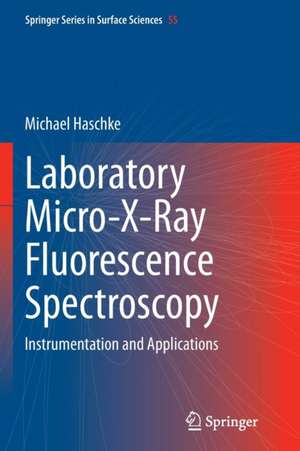Laboratory Micro-X-Ray Fluorescence Spectroscopy: Instrumentation and Applications: Springer Series in Surface Sciences, cartea 55
Autor Michael Haschkeen Limba Engleză Paperback – 23 aug 2016
| Toate formatele și edițiile | Preț | Express |
|---|---|---|
| Paperback (1) | 948.29 lei 6-8 săpt. | |
| Springer International Publishing – 23 aug 2016 | 948.29 lei 6-8 săpt. | |
| Hardback (1) | 952.89 lei 6-8 săpt. | |
| Springer International Publishing – 22 mai 2014 | 952.89 lei 6-8 săpt. |
Din seria Springer Series in Surface Sciences
- 18%
 Preț: 1131.25 lei
Preț: 1131.25 lei - 15%
 Preț: 654.77 lei
Preț: 654.77 lei - 18%
 Preț: 1113.09 lei
Preț: 1113.09 lei -
 Preț: 390.63 lei
Preț: 390.63 lei -
 Preț: 407.98 lei
Preț: 407.98 lei - 15%
 Preț: 657.57 lei
Preț: 657.57 lei - 15%
 Preț: 636.63 lei
Preț: 636.63 lei - 15%
 Preț: 641.20 lei
Preț: 641.20 lei - 15%
 Preț: 651.19 lei
Preț: 651.19 lei - 15%
 Preț: 645.60 lei
Preț: 645.60 lei - 15%
 Preț: 632.70 lei
Preț: 632.70 lei - 15%
 Preț: 640.24 lei
Preț: 640.24 lei - 15%
 Preț: 646.11 lei
Preț: 646.11 lei -
 Preț: 397.38 lei
Preț: 397.38 lei -
 Preț: 386.22 lei
Preț: 386.22 lei -
 Preț: 387.75 lei
Preț: 387.75 lei -
 Preț: 389.31 lei
Preț: 389.31 lei -
 Preț: 399.12 lei
Preț: 399.12 lei -
 Preț: 406.42 lei
Preț: 406.42 lei - 18%
 Preț: 1011.14 lei
Preț: 1011.14 lei - 18%
 Preț: 2100.88 lei
Preț: 2100.88 lei -
 Preț: 398.35 lei
Preț: 398.35 lei -
 Preț: 392.21 lei
Preț: 392.21 lei -
 Preț: 389.88 lei
Preț: 389.88 lei - 15%
 Preț: 646.43 lei
Preț: 646.43 lei - 15%
 Preț: 643.16 lei
Preț: 643.16 lei - 15%
 Preț: 643.65 lei
Preț: 643.65 lei - 18%
 Preț: 948.79 lei
Preț: 948.79 lei - 15%
 Preț: 641.03 lei
Preț: 641.03 lei - 15%
 Preț: 640.55 lei
Preț: 640.55 lei - 15%
 Preț: 640.71 lei
Preț: 640.71 lei - 18%
 Preț: 952.72 lei
Preț: 952.72 lei - 18%
 Preț: 955.08 lei
Preț: 955.08 lei - 15%
 Preț: 648.42 lei
Preț: 648.42 lei - 15%
 Preț: 641.03 lei
Preț: 641.03 lei - 18%
 Preț: 1000.42 lei
Preț: 1000.42 lei - 18%
 Preț: 952.57 lei
Preț: 952.57 lei - 18%
 Preț: 1001.02 lei
Preț: 1001.02 lei
Preț: 948.29 lei
Preț vechi: 1156.45 lei
-18% Nou
Puncte Express: 1422
Preț estimativ în valută:
181.45€ • 189.45$ • 150.18£
181.45€ • 189.45$ • 150.18£
Carte tipărită la comandă
Livrare economică 05-19 aprilie
Preluare comenzi: 021 569.72.76
Specificații
ISBN-13: 9783319353029
ISBN-10: 3319353020
Pagini: 374
Ilustrații: XVIII, 356 p. 254 illus., 107 illus. in color.
Dimensiuni: 155 x 235 x 20 mm
Greutate: 0.53 kg
Ediția:Softcover reprint of the original 1st ed. 2014
Editura: Springer International Publishing
Colecția Springer
Seria Springer Series in Surface Sciences
Locul publicării:Cham, Switzerland
ISBN-10: 3319353020
Pagini: 374
Ilustrații: XVIII, 356 p. 254 illus., 107 illus. in color.
Dimensiuni: 155 x 235 x 20 mm
Greutate: 0.53 kg
Ediția:Softcover reprint of the original 1st ed. 2014
Editura: Springer International Publishing
Colecția Springer
Seria Springer Series in Surface Sciences
Locul publicării:Cham, Switzerland
Cuprins
XRF-Basics.- Main Components of X-Ray Spectrometers.- Special Requirements for µ-XRF.- Quantification.- Sample Preparation.- Relations to Other Analytical Methods.- Applications.
Notă biografică
Michael Haschke was born 1948, his schooling was combined with teachings for metalworker. After the study of physics at the TU Dresden which was finished 1974 with PhD he started his career – at first in the Academy of Science of GDR, branch for scientific instrumentation and then in different companies. From the beginning of the 80th he was working in the field of X-Ray analytics. During that time he was responsible for the introduction of energy-dispersive X-Ray spectrometers (EDS) in GDR, for the buildup of the X-Ray product line in Spectro, Kleve including the excitation with polarized radiation, the use of small spectrometers for jewelry analysis and the introduction of poly-capillary based instruments for µ-XRF in Röntgenanalytik Messtechnik GmbH, Taunusstein in close cooperation with EDAX, USA, the use of µ-XRF as an additional excitation source for electron microscopes in IfG, Berlin and finally for the introduction of a complete product line for µ-XRF in Bruker Nano, GmbH, Berlin. This responsibility was realized as deputy-director or product manager in the different companies. He understood the introduction of new instruments as a combination of the development of the instruments with the introduction into the market. Therefore there is a big experience both for instrumentation as well as for application.
Textul de pe ultima copertă
Micro-X-ray fluorescence offers the possibility for a position- sensitive and non-destructive analysis that can be used for the analysis of non-homogeneous materials and layer systems. This analytical technique has shown a dynamic development in the last 15 years and is used for the analysis of small particles, inclusions, of elemental distributions for a wide range of different applications both in research and quality control. The first experiments were performed on synchrotrons but there is a requirement for laboratory instruments which offers a fast and immediate access for analytical results. The book discuss the main components of a µ-XRF instrument and the different measurement modes, it gives an overview about the various instruments types, considers the special requirements for quantification of non-homogeneous materials and presents a wide range of application for single point and multi-point analysis as well as for distribution analysis in one, two and three dimensions.
Caracteristici
Gives a description of the main instrumental influences on the analytical performance Discusses the different quantification models of X-ray measurements considering the special requirements to the analysis of non-homogeneous materials Supplies an overview of X-ray fluorescence applications with various suggestions for the use of the analytical potential of this method Includes supplementary material: sn.pub/extras







